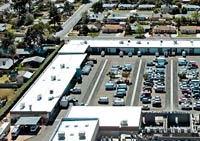view all Case Studies
School District Stays Cool, Saves Money with Roof Restoration

Mesa (Ariz.) Public Schools is the 39th largest school district in the United States with 74,000 students. The district needs dozens of classroom buildings and other facilities to accommodate its large number of students and staff. Properly maintaining these structures, especially roofs, is critical to overall district operations.
December 3, 2008 -
Roofing
Mesa (Ariz.) Public Schools is the 39th largest school district in the United States with 74,000 students. The district needs dozens of classroom buildings and other facilities to accommodate its large number of students and staff. Properly maintaining these structures, especially roofs, is critical to overall district operations.
Roofs take the brunt of the extreme Arizona heat, harsh sun and damaging ultraviolet (UV) rays. As a result, the district is looking for new and better roofing systems for many of the buildings.
The original, 28-year-old gravel roof on the district’s single-story operations and maintenance facility was reaching the point of disrepair. The 500-square-foot roof endured a number of penetrations over the years when workers installed new mechanical equipment, electrical lines and building components. It was time to install a new roof.
“With the extreme heat in our area, we wanted a product that offered good reflectivity and energy savings,” says Keith Pickens, senior structural lead for the district. “We also wanted a roof system that was environmentally friendly and a solution that wouldn't contribute to waste in landfills.”
With several districtwide projects going on simultaneously and the area’s rainy season around the corner, Pickens did not want to tear off the roof completely. He believed an open roof deck would expose the operations and maintenance building’s interior.
Pickens looked at a variety of alternatives and products to find a solution.
Chris Adcock, an APOC territorial manager, met with the district and proposed an elastomeric coating as part of a complete roof-restoration system, not just a top dressing. APOC applied the product on a section of the roof so Pickens could evaluate how it performed.
Using an asphalt emulsion and chopped glass applied simultaneously, a base coat of the APOC Monoform system created a new layer of protection. The topcoat was APOC 252 Sunwhite elastomeric coating, which features a white finish that keeps the roof cool and protects the underlying roofing layers from sun and water damage.
The APOC products are more environmentally responsible because both the Monoform emulsion and the white coating are water-based, reducing the amount of volatile organic compounds released into the atmosphere. There also are no fumes, harsh odors or fire hazards associated with the products.
A contractor prepared the roof by removing loose gravel and other debris. The crew then ground down the remaining gravel and pressure-washed the surface. After completing the prep work, the crew applied the Monoform system and the elastomeric coating as the topcoat.
Pickens took heat readings throughout the process. The temperature on the original gravel roof exceeded 160 degrees. Before applying the finish coat, a reading on the base coat was 135. After completing the new roof, the temperature on the finished coat was 115 degrees in the sun and 103 degrees in the shade.
“We got a 32 degree difference between the base coat and top coat and more than a 55 degree difference from the old roof to the new roof,” Pickens says. “That's a significant temperature change. So, the mechanical (system) will not have to work as hard, and we're going to see a considerable utility savings.”
Next
Read next on FacilitiesNet










